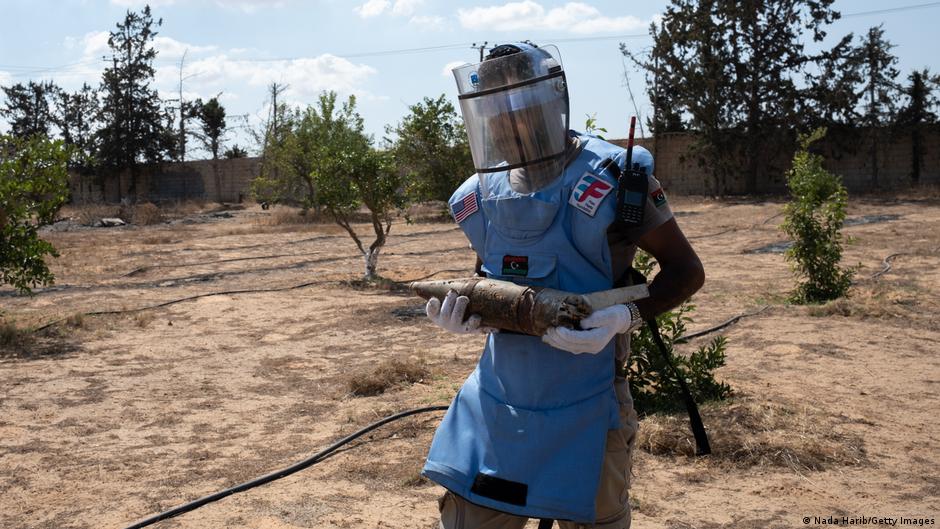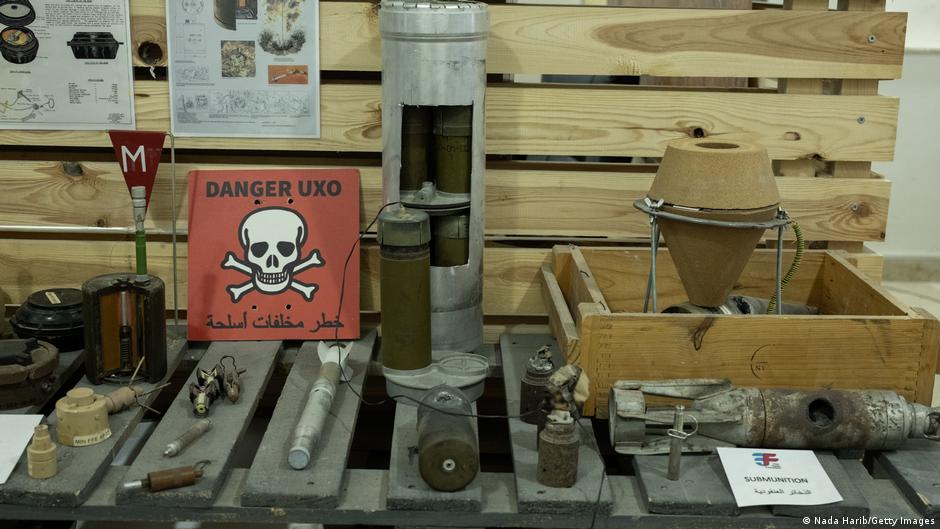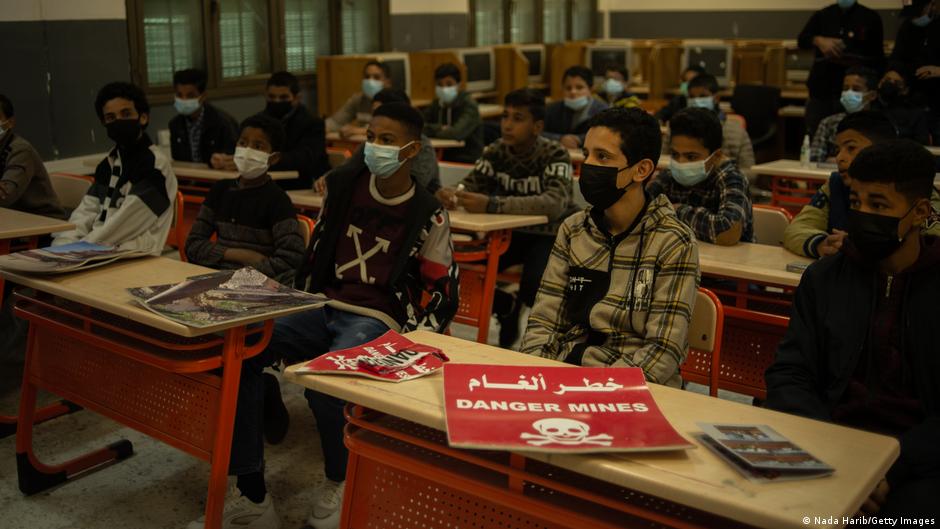Dealing with more than bombs

Despite the danger, her family's fears and the potential for criticism from Libyan society at large, Farah al-Ghazali, one of Libya's first female de-miners, said she didn't hesitate when she got the opportunity to help rid her country of land mines.
"I didn't look back," she said. "My family told me to be careful and I told them I would be. I told them about all the good things we can do for people here. I also give my family and friends advice about what they should do if they see a land mine or an explosive device," the 30 year-old continued enthusiastically.
Although accurate data is hard to come by in Libya due to years of conflict, the Landmine and Cluster Munition Monitor reports that over the past 15 years, more than 400 Libyans have been killed by land mines or unexploded ordinances and over 3,000 have been injured. The true number is likely to be much higher though, they note, and the ongoing removal of unexploded ordinances remains a challenge.

It is a challenge that al-Ghazali and five other women are hoping to help tackle. They all trained from November 2021 until January 2022, on a course near the Libyan capital, Tripoli, and have since gone on to work for various de-mining organisations, including the Defence Ministry and the Libya-based mine action organisation, Free Fields Foundation.
Another participant, 29-year-old arts graduate Amal Mustafa, explained that there were several stages to the training. Wearing heavy helmets and wielding metal detectors, she said, the women were taught to identify the most dangerous areas that likely held mines and how to defuse and remove them.
Mustafa said her family had also been really worried about her doing this job, but that still encouraged her to do the training.
Land mines still being planted
Land mines remain a serious problem in many parts of Libya. Although not all areas have been thoroughly surveyed, in January 2020, the United Nations estimated that the country was littered with around 20 million mines or explosive remnants.
The explosives are left over from a variety of conflicts, including from World War II, conflicts with Egypt and Chad in the 1970s and 1980s and various border disputes. Since long-time dictator Muammar Gaddafi was deposed and killed in 2011, two opposing factions have vied to govern the country.
More land mines and improvised explosive devices, or IEDs, were allegedly planted by forces loyal to Khalifa Haftar, who continues to control much of the east of the country. In 2022, Human Rights Watch reported that the Russian mercenary group Wagner, which was supporting Haftar, had planted land mines and booby traps near Tripoli as recently as 2020.
According to rights organisations, at least 130 locals have been killed by land mines or stray explosives since Haftar's forces withdrew from the outskirts of the city in 2021.
"This job is like a direct confrontation with death," explained Aseel al-Ferjani, 28, another of Libya's new female de-miners. "The mines don't care if you make a mistake and they don't give you a second chance."
"They say my work is dangerous and this is true, it's 1000% dangerous," agreed Huda Khaled, a 33 year-old de-miner originally from Iraq. But, she added, as an Iraqi, she's seen worse. "We spent years watching explosions in our markets and streets. The danger of de-mining is similar to our daily lives there," she said.
Libyan society disapproves
The obvious dangers are not the only challenges that the female de-miners have to deal with, explained Mahmoud al-Alam, who trained the women.
In Libya, the job was long considered to be something only men should be doing, he said. "The participants faced many challenges because of customs and traditions in a conservative country that limit women's work in general. So you can imagine what it's like in a field like de-mining."
"[The field] is traditionally quite male-dominated because of its historic affiliation with militaries," agreed Abigail Jones, program manager for gender, diversity, equality and inclusion at the Geneva International Centre for Humanitarian Demining. "So historically, women have faced more barriers to employment, particularly in explosive disposal or de-mining roles."
But this has been changing since humanitarian de-mining began in 1988 in Afghanistan, Jones continued. There is now an unquestioned international push to promote gender equality in the sector, she said.
The first all-female de-mining team was created by a Norwegian aid organisation in Kosovo in 1999. Today there are female de-miners working in 25 different countries, including Iraq, Lebanon, Sudan, Myanmar, Cambodia and Jordan, Jones said.
“Last year alone, The UN was able to verify that at least 26 children in Libya were killed or injured due to explosive remnants of war.
“UNICEF calls on all parties to spare no effort to clear Libya of land mines & unexploded ordnances & support children & families affected.— UNICEF Libya (@UnicefLibya) March 27, 2022
A 2019 survey of international non-governmental organisations working in this field found that now, on average, women made up about 20% of staff engaged in active de-mining jobs.
Who is best at de-mining?
As more women have entered the sector, there's been some discussion about which gender is actually better at the job.
The criticism around women's involvement has included tenuous arguments about females being physically weaker and supposedly taking longer to clear explosives, as well as fears they might need to take more time off work due to things like maternity leave.
But others have argued that women might actually be better at de-mining because, as one study put it, they are reportedly more cautious and patient and tend to work more collaboratively in teams. That is, they don't feel the need to rush in to prove how tough they are.

A more definitive answer to the question was provided by a study published in the autumn 2022 edition of The Journal of Conventional Weapons Destruction. Researchers looked at de-mining programmes in 14 different countries, investigating how many square metres of land different genders had cleared and their availability to work regularly, as well as how many days they took off.
"Stereotypes and unproven assumptions persist", the researchers concluded. But, "a quantitative analysis of the data found no meaningful difference in operational productivity or availability to work … based on gender".
Female de-miners transforming communities
Including women in de-mining work is not just a matter of offering half the population equal opportunities, pointed out Jones from the Geneva International Centre for Humanitarian Demining. She said studies from places such as Sri Lanka and Lebanon where women de-miners are more established showed that their inclusion can "transform gender norms at community level".
"This manifests in a number of ways. It helps challenge perceptions that might exist about women's ability to perform the same jobs as men. It can help to increase women's influence over decision-making at the community level, but also within the family. And it also provides them with financial independence," said Jones. "So the transformative impact of employing women in these roles is quite significant."
As for newly-trained Libyan de-miner, Farah al-Ghazali, she is just pleased that she was able to "defy conventional thinking" in her homeland. "I want to show that women can do what men can and I want to continue to do my best," she said.
"Every year I get better, I get training and I get more experience, I am always learning things. And," she concludes happily, "I know I am helping people through my work."
Cathrin Schaer & Islam Alatrash
© Deutsche Welle 2023